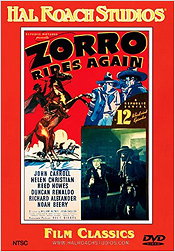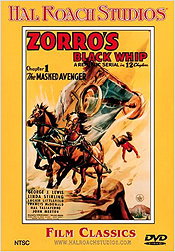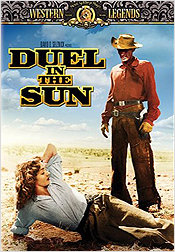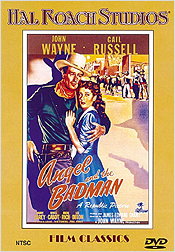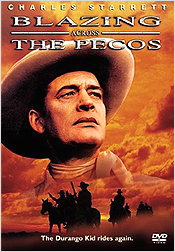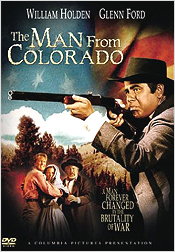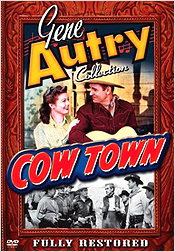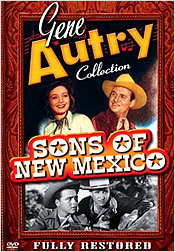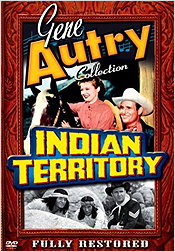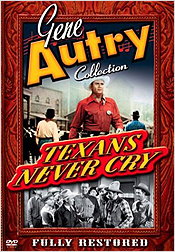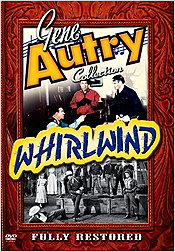 |
Site created 12/15/97.

page created: 10/4/04
 Barrie Maxwell - Main Page |
|
| Classic
Reviews Roundup #10 - October 2004 This time it really is a round-up as I look at 22 western films (actually 18 western films, 2 western serials, 1 western TV series, and 1 John Wayne biography) that have appeared mainly over the past few months. Zorro Rides Again (1937) Zorro's Black Whip (1944)/The Bold Caballero (1936) (released on DVD by Image on August 3rd, 2004) Inspired by the success of The Vigilantes Are Coming, a 1936 serial starring Robert Livingston and featuring a masked avenger, Republic decided to resurrect Zorro - a character that had lain dormant since Douglas Fairbanks's portrayals in the mid-1920s. As a warm-up, it used Robert Livingston once again in the 1936 feature The Bold Caballero, which basically played out the traditional Zorro story of the masked Robin Hood who deals with the Spanish oppressors of the put-upon natives. Livingston was being built up by Republic as a star of its more major productions at the time, but he looks uncomfortable in much of the film. The 69-minute production is a little ragged, with less-than-persuasive sword fights for example, as Republic was not yet the well-oiled western-making machine that it would soon become. It also suffers from the use of Sig Rumann as the chief villain. Rumann reminds one too much of his more comedic roles (in the likes of A Night at the Opera, To Be or Not to Be) to be taken really seriously as an evil commandant. The film was shot using an early two-colour process. |
|
|
|
In 1937, Republic embarked on its first true Zorro serial - Zorro Rides Again. The 12-chapter effort features John Carroll in the title role, as the great grandson of Zorro returns to California where he must try to prevent the takeover of the California-Yucatan Railroad by a nefarious investment banker named Marsden. Duncan Renaldo appears as Zorro's loyal friend; Noah Beery Sr. plays Marsden; and Richard Alexander is the latter's main henchman, El Lobo. The plot is one of the then-popular blends of the old west with more modern elements such as planes and trucks. This allowed for a little more variety in the chapter endings than was otherwise the case with western serials. Republic was hitting its stride by this time, and with the directing team of William Witney and John English in charge, the action is plentiful and generally well-mounted. Unfortunately, the serial's resolution is handled in a rather cursory fashion, undoing some of the earlier momentum. After another dip at the Zorro well in the superior Zorro's Fighting Legion (1939) serial, Republic took a break for five years before apparently returning to the character in 1944 with the 12-chapter serial Zorro's Black Whip. I say "apparently" because the only appearance of Zorro is in the serial's title. The main character is a mysterious avenger called The Black Whip who certainly dresses like Zorro and uses a whip, but that's as far as it goes. The Black Whip provides assistance to government agent Vic Gordon who is working undercover in Idaho where he is trying to root out a gang of outlaws intent on preventing the coming of law and order that would accompany the territory becoming a state. One of the serial's chief assets is the presence of serial queen Linda Stirling who early on assumes the role of The Black Whip. George Lewis, more often a heavy, plays the role of Vic Gordon likably and with good authority. Familiar face Francis McDonald is the brains behind the outlaws and his chief henchmen are portrayed by the likes of Hal Taliaferro and John Merton - typical roles for them. Direction this time was by the team of Spencer Bennet and Wallace Grissell who had a significantly smaller budget to work with than nearly any other Republic serial due to wartime belt-tightening. This translated into shorter chapter lengths and the use of a retrospective chapter two-thirds of the way through the serial. Action was once again well-staged, reflecting second unit work by Yakima Canutt. Overall, the serial is an entertaining outing, but no more than an average entry in the Republic serial canon. Various Republic Zorro serials are available from many sources including Roan Group, VCI, the Serial Squadron, and Image. The latter's are the versions reviewed here and are being put out under the Hal Roach Studios imprint. All are quite watchable, although none will be mistaken for the better restorations of classic titles available from the likes of Warner Brothers or Fox. Each is described as being "mastered from original 35mm nitrate camera negative and fine grains". Zorro Rides Again is presented full frame as originally shot. The image is a little schizophrenic, ranging from reasonably crisp one minute to somewhat washed out the next. Contrast is a problem at times and numerous scratches and speckles are present. The mono sound is clear enough, but hiss and crackle are in evidence. There is no sub-titling. Included as extras are trailers for six Republic serials - Darkest Africa, Radar Men from the Moon, Robinson Crusoe of Clipper Island, SOS Coast Guard, The Undersea Kingdom, and Zorro Rides Again. Faring somewhat better is Zorro's Black Whip, also correctly presented full frame. The image is more consistently clear and fairly crisp, although there are occasions when it deteriorates a bit. Shadow detail is fairly good. The mono sound is once again quite workable, with less hiss than on Zorro Rides Again. There is no sub-titling. As a special bonus, the disc includes the full-length feature The Bold Caballero. The version presented is a black and white one mastered from the "red element" that survives from the original two-colour process in which the film was shot. The image is workable but overall is in the poorest shape of the three titles reviewed here. It's clear enough overall, but often suffers from blooming of the whites and general softness. Shadow detail suffers accordingly, and speckles and scratches abound. The mono sound is about on a par with that of Zorro Rides Again. For Zorro fans, however, it's a pleasure to have this available and is a strong selling point for the Zorro's Black Whip disc. It seems strange then that you only know it's on the disc if you read the back of the case. Due to its inclusion of The Bold Caballero, the Zorro's Black Whip disc is recommended. Duel in the Sun (1946) (released on DVD by MGM on May 25th, 2004) Producer David O' Selznick wasn't exactly a big western fan, but in Niven Busch's novel of the McCanles family (a tale somewhat notorious for some steamy sex scenes between one of the McCanles sons, Lewt, and Pearl Chavez, a young half-breed), Selznick saw an opportunity for Jennifer Jones, with whose career he was becoming obsessed. Selznick managed to secure the film rights and set about mounting a Gone-with-the-Wind-like production. It was Selznick's feeling that combining more spectacle than had ever been seen in a western along with a violent love story would lead to great success. Nine months of shooting in 1945 characterized by endless rewrites, retakes, union disputes, and the eventual walk-out of director King Vidor all resulted in costs of almost $5 million and over 26 hours of film. An initial cut of almost four hours was previewed to unsatisfactory results, leading to further retakes and additional scenes which were massaged into a cut of 138 minutes for the film's official opening. Further cuts then had to be made to placate various censorship groups in order to ensure the film's financial success during its countrywide release. As it turned out, Selznick need not have worried. The public flocked to the film. |
|
| MGM
presents the film full frame in accord with the original aspect
ratio. This is apparently the same source material that Anchor Bay
had for its previous (and second) release of the title. It's the
roadshow version complete with Tiomkin's overture and exit music,
for a running time of 146 minutes. The Technicolor image is in very
fine shape with both good colour fidelity (there is a slightly
heightened reddish cast to the image, but this may have been
intentional) and decent shadow detail. There are very few blemishes
to be seen. Some minor edge effects are the only detraction from
what is quite a sharp presentation. The results are fairly similar
to what Anchor Bay achieved on its disc; at most MGM's is slightly
sharper. The mono sound track is quite adequate for the job although
there is noticeable distortion at higher volumes. Anchor Bay's disc
did not suffer from this to the same extent. English, French, and
Spanish subtitles are included. The only extra is the original
theatrical trailer. If the sub-titles are not an important
consideration, there's no reason to trade in the previous Anchor Bay
disc should you have it. Angel and the Badman (1947) (released on DVD by Image on Oct. 29th, 2002) A couple of superior John Wayne westerns from the mid-1940s often tend to get overlooked. One is Tall in the Saddle, which was a 1944 RKO release that is sometimes regarded as Wayne's best western work since Stagecoach. Unfortunately it's not available on DVD as yet. The second is Angel and the Badman (a 1947 Republic release) which is available on DVD from a number of sources because of its apparent public domain status. It was John Wayne's first foray into production himself. He took the plunge with this particular film because the story with its strong central character appealed to him and it was written by a good friend, James Edward Grant. Wayne plays badman Quirt Evans who is nursed to health by a family of Quakers after being shot. He and the young Quaker daughter, Penny Worth, gradually fall in love as Quirt comes to appreciate the virtues of the Quaker lifestyle. Meanwhile, old nemesis Laredo Stevens threatens Quirt's future while U.S. marshal Wistful McClintock remains watchful should Quirt revert to his old ways. |
|
| The
version reviewed here is one issued by Image Entertainment as part
of its Hal Roach Studios line of releases. The full frame image (in
accord with the original aspect ratio) is quite workable. For a
public domain release, the presentation is a mixture of sharp and
soft sequences with the former dominating. Night-time sequences are
rather murky. The image is free of edge effects. The mono sound is
adequate, although there is plenty of hiss in evidence. There is no
sub-titling. Extras include trailers for six serials. The film is
also available on DVD from Roan Group, but its transfer is somewhat
inferior to Image's. Blazing Across the Pecos (1948) (released on DVD by Columbia on Sept. 14th, 2004) Columbia's most enduring cowboy star was Charles Starrett. His debut western was 1935's Gallant Defender and for the next 17 years he appeared virtually exclusively in westerns for the studio. In 1940, he appeared in a masked avenger story called The Durango Kid wherein he played the title role. At the time, this was a one-shot effort as far as the character was concerned, but in 1945, Columbia resurrected the Durango Kid character for Starrett in Return of the Durango Kid. Starrett would play the character in all his remaining westerns. |
|
| Columbia
has just released this title on DVD. One really wonders what the
thinking process is over there. You would think that if you were
interested in making money from such a release, you would look to
the better entries in the series and showcase them so that fans feel
they're not being taken. The choice of a poor Durango Kid western,
with a running time of less than an hour, alone on a single disc at
a SRP of $19.95 is not going to result in much business. Why not at
least pair the first two Durango Kid westerns on a single disc and
see what sort of interest one might generate, rather than the
market-killing approach that Columbia has taken? For those who care,
the disc's full frame presentation is fine - quite a crisp and
relatively blemish-free image for such a minor item. The mono sound
is adequate. Extras consist of three preview trailers that can only
be watched all together. One of them is for Bridge
on the River Kwai, which tells you all you need to know
about the amount of thought that Columbia has put into this release. The Man from Colorado (1948) (released on DVD by Columbia on June 8th, 2004) Glenn Ford was one of those actors you could always rely upon for a good, steady performance. His was a career of fine if seldom scintillating portrayals and at age 88, he is now one of the few remaining stars of the Golden Age still alive. During the 1940s and early 1950s, he was under contract to Columbia and appeared in several memorable films of the period including Gilda and The Big Heat. Even from early in his career, he appeared comfortable if somewhat fresh-faced in western films such as The Desperadoes (1943) and Texas (1941), the latter with a young William Holden. In 1948, a more mature-looking Ford reteamed with Holden to make The Man from Colorado, a superior western entry for that year. The story concerns Civil War officer Owen Devereaux who comes to love killing and whose violent behaviour continues when he becomes a judge after the war is over. Del Stewart, Owen's friend and fellow-officer during the war and town marshal under Devereaux thereafter, tries to restrain Devereaux's violent tendencies. But when former soldiers find themselves unfairly dealt with by Devereaux, they take up arms against him and Stewart and Devereaux eventually find themselves pitted against each other. |
|
| Columbia
has done a fine job on this Technicolor film. The full-frame image
(consistent with the original aspect ratio) is bright and colourful,
capturing the rich Technicolor palette accurately. The picture is
sharp and clear with fine shadow detail. Only occasional speckles
mar an otherwise exemplary effort. The mono sound is quite adequate,
free from age-related hiss or distortion. English and Japanese
subtitles are provided. The disc includes several trailers but none
for The Man from Colorado.
Recommended. Cow Town (1950) Sons of New Mexico (1950) (released on DVD by Image on May 25th, 2004) Indian Territory (1950) Texans Never Cry (1951) (released on DVD by Image on July 13th, 2004) Whirlwind (1951) (released on DVD by Image on September 14th, 2004) In 1947, Gene Autry took his production unit from Republic to Columbia where he would remain for the remainder of his feature film career (it ended in 1953). The Columbia releases were produced under the Gene Autry Productions banner with Armand Schaefer as producer and the direction most commonly by Frank McDonald, John English, and latterly George Archainbaud. During this period, Autry's on-screen persona assumed a less flamboyant look with more conservative dress, and there was an emphasis on fisticuffs. Gene was obviously adept at the latter and demonstrated it in the films, but there was less attention to it than to elaborately staged and gritty fights. Two or three songs continued to be featured in each film. In the later Columbias, Gail Davis was usually the female lead with first Pat Buttram and then Smiley Burnette providing comic relief. Over the past five months, Image has released a half dozen more titles in its continuing collection of Autry titles. These all date from the middle of his Columbia period and range in quality from mediocre to very good in terms of entertainment value. Five of these releases are reviewed here. |
|
|
|
Whirlwind is the best of the bunch. In it, Gene is a postal inspector who tries to crack a well-organized gang of robbers headed by rancher Big Jim Lassiter. The story is well-crafted and photographed, and is punctuated with some good action sequences. As was common with his Columbia films, Gene looks more natural and comfortable in his role than he did in many of his previous Republic outings. The supporting cast is excellent with Thurston Hall as Big Jim and the likes of Harry Lauter, Dick Curtis, and Kenne Duncan as his henchmen. Smiley Burnette replaces Pat Buttram as Gene's sidekick for this entry. In Texans Never Cry, Gene plays a Texas Ranger on the trail of a gang of counterfeiters dealing in phony Mexican lottery tickets. This one's not quite in Whirlwind's class because its story seems a little thin for the 68-minute running time and the supporting players don't particularly stand out. Pat Buttram is around and the action content is fine, however. Indian Territory is a pretty traditional entry, story-wise, in which Gene plays an undercover Indian agent intent on getting to the bottom of several Indian uprisings. The film offers attractive camera work and reasonable action, but is no more than standard Autry fare. James Griffith is not particularly effective as one of the bad guys. Gene somehow manages a rendition of "Chattanooga Shoeshine Boy". Sons of New Mexico finds Gene the guardian of a deceased friend's son who falls under the influence of gamblers. He sends the son to the New Mexico Military Institute to straighten the boy out, hence the film's title. This one offers a somewhat novel plot for a B western, and the story is well executed by director John English. Robert Armstrong makes for a good villain, and Clayton Moore (TV's Lone Ranger) makes a welcome appearance. This marked Gail Davis's first appearance in one of Gene's westerns. Cow Town is the most disappointing of this bunch. The story finds rancher Gene Autry intent on using the new invention of barbed wire to save his cattle from rustlers. Gene's performance is very perfunctory and the action (aside from a fight with Jock Mahoney) and supporting cast are not inspiring. Some of the songs are more awkwardly integrated into the story than usual. Image's DVD presentation of each of these films is quite similar. The transfers (correctly presented full frame) are quite good with crisp images, good shadow resolution, and nicely detailed gray scales. There is very minor speckling and some grain in evidence (the latter somewhat more noticeable on Whirlwind than the others), but only minimal edge effects. Autry fans should be very pleased with what they see. The mono sound is in good shape and is generally free of significant hiss or crackle. Each disc contains the reminiscences provided by Gene Autry and Pat Buttram on the "Melody Ranch Theater" television presentations of the films; excerpts from the original "Melody Ranch Radio Show"; poster, lobby card, and production still galleries; original press kit material, and the original theatrical trailer. All are recommended for Autry fans, but if you only want one, Whirlwind is the one to get. |
On to Part Two
Barrie Maxwell - Main Page
 |
| Site
designed for 1024 x 768 resolution, using 16M colors and .gif 89a
animation. © 1997-2015 The Digital Bits, Inc., All Rights Reserved. billhunt@thedigitalbits.com |
